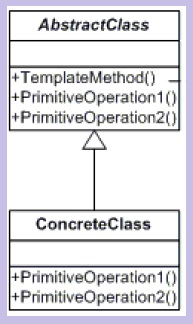Introduction
This article talks about the Template method design pattern, when could this pattern be useful and what
benefits we can get from it. This article also presents a rudimentary implementation of template design pattern
in C#.
Background
There are some scenarios in our application where we would wanna perform some activity but the algorithm
to perform that task may vary. Such scenarios can be designed using Strategy pattern so that the basic code
that performs the operation will remain the same and the algorithm to perform the task can be switched
dynamically. For details on strategy pattern refer: Understanding and Implementing the Strategy Pattern in C# and C++[^]
Now there might be some scenarios where the actual algorithm to perform the task will remain the same
but some step of that algorithm can be different from the implementation perspective. Now since the algorithm
is same in these scenarios and thus implementing strategy pattern will be an overkill for it. What we can do
in such scenarios is that we can use the power of inheritance to achieve this(instead of composition that strategy
pattern provides).
The template method pattern is useful in such scenarios where there is an algorithm and some small part of
that algorithm may vary. GoF defines Template method pattern as "Define the skeleton of an algorithm in an
operation, deferring some steps to subclasses. Template Method lets subclasses redefine certain steps of
an algorithm without changing the algorithm's structure.".

In the above shown class diagram
AbstractClass: This class mainly contain 2 type of methods. First it contain methods for each step of
the algorithm. Second method in this class is the
Template method. Template method is the method which used all the individual methods and provides a
skeleton for execution of the algorithm.ConcreteClass: This class contain override the methods Abstract class provides for each step of algorithm.
They contain the custom implementation of these steps step. This class will contain the default implementation of these steps.
Using the code
Let us now try to look at a sample implementation of this this pattern in C#. Let us assume that
we have a class that reads the data from a data source and then creates a file for MIS reporting purpose.
abstract class DataExporter
{
public void ReadData()
{
Console.WriteLine("Reading the data from SqlServer");
}
public void FormatData()
{
Console.WriteLine("Formating the data as per requriements.");
}
public abstract void ExportData();
public void ExportFormatedData()
{
this.ReadData();
this.FormatData();
this.ExportData();
}
}
The implementation of the ReadData and FormatData will not change as per the requirements.
The only changeable part is the ExportData function whose implementation will change based on the
target file to export to. So if we need to export the data to an excel file we need a ConcreteClass for
that.
class ExcelExporter : DataExporter
{
public override void ExportData()
{
Console.WriteLine("Exporting the data to an Excel file.");
}
}
Similarly if we need to export the data to a PDF file we will be needing another concrete class
for that overriding only the export part of the algorithm.
class PDFExporter : DataExporter
{
public override void ExportData()
{
Console.WriteLine("Exporting the data to a PDF file.");
}
}
Now the benefit here is that the DataExporter class will be used by the application and
the required implementation of the algorithm will be taken from the derived classes.
static void Main(string[] args)
{
DataExporter exporter = null;
exporter = new ExcelExporter();
exporter.ExportFormatedData();
Console.WriteLine();
exporter = new PDFExporter();
exporter.ExportFormatedData();
}
So we have seen that the actual algorithm to export the data remains the same but the part where the
file type to export to can be moved into the derived classes. The template method will remain oblivious to
the implementation and will run the algorithm. At run time it will call the derived classes overridden
function to execute the required functionality.
Before wrapping up let us look at the class diagram of our dummy application and compare it with the
class diagram of Template method pattern.

Point of interest
In this article, we have tried to see why and when we might find the template method pattern useful.
We have also seen a rudimentary implementation of the template method pattern in C#. Template method
pattern is a very good example of the Hollywood principle i.e. "Don't call us, we will call you" in a way that
the template method will always remain oblivious to the actual implementation but whenever needed it
will call the subclass to get the functionality in place. I hope this small article has been informative.
History
- 23 October 2012: First version.
